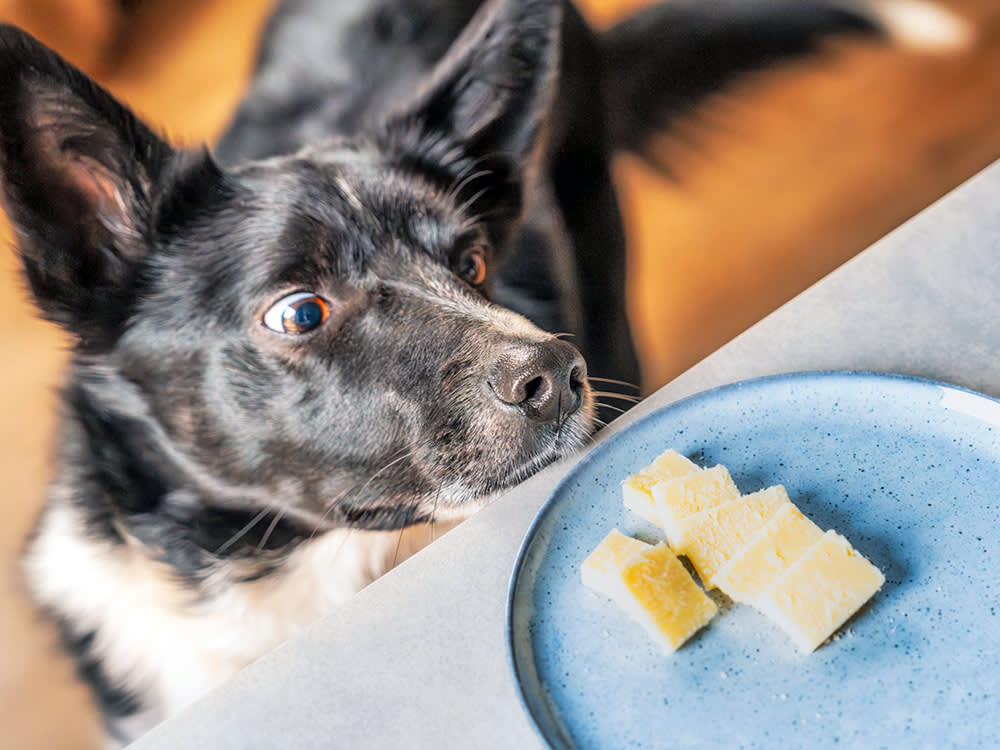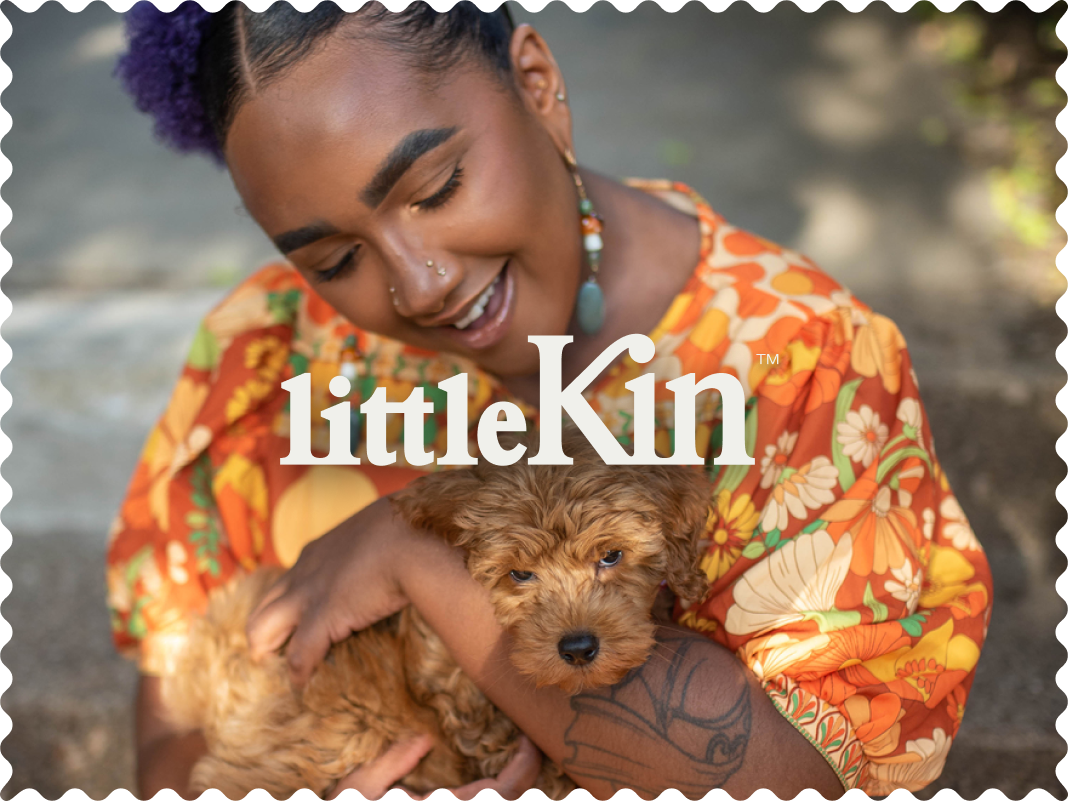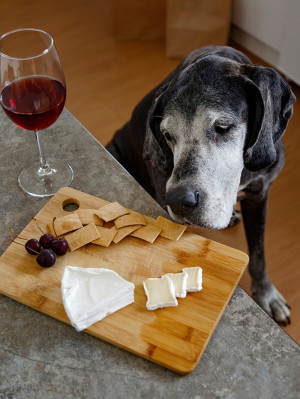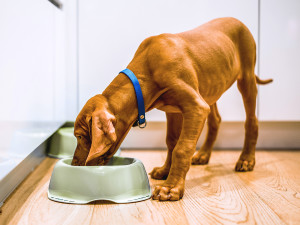Can Dogs Have Parmesan Cheese?
Find out if this popular cheese safe for them to nosh on.

Share Article
In This Article:
What Is Parmesan Cheese? Can Dogs Safely Eat Parmesan Cheese? How to Safely Give Your Dog Parmesan Cheese Alternative Cheese Options for Dogs
Dog parents love to share a human food treat with their pups from time to time. Sometimes, that’s perfectly fine, but other times? Not so much. Many everyday human foods aren’t just unhealthy for dogs — they can be outright dangerous for your pup.
We tend to think that something as bland-looking as cheese couldn’t possibly be bad for your dog. But the reality is that some dogs tolerate small amounts of cheese, while others get stomach upset, diarrhea, or worse due to lactose intolerance or high fat and salt content. Certain cheeses also contain seasonings or additives that aren’t dog-safe. So, before you slip a cheesy bite under the table, it’s worth asking: Is cheese really a good choice for pets, or could it do more harm than good?
How much do you spend on your pet per year?

What is Parmesan cheese?
Parmesan — or Parmigiano-Reggiano, when it’s the authentic Italian heavyweight — is a hard, aged cow’s milk cheese that takes months to years to age. Aging creates a nutty, savory flavor as well as tiny, crunchy crystals that make foodies swoon. During the process, lactose is also reduced to very low levels. Authentic Parmesan cheese consists of only three ingredients: milk, salt, and rennet. Other pre-grated varieties include anti-caking agents and more salt. Parmesan cheese is very flavorful, low in lactose, naturally high in sodium, and calorie-dense for its size.
Can dogs safely eat Parmesan cheese?
The problem with Parmesan cheese for both people and dogs is its high salt and fat content. For healthy adult dogs, a dusting of Parmesan once in a while is usually fine. Treat it like a garnish, not a snack. It’s OK for healthy dogs to eat occasionally, but you should have your vet’s approval.
Keep portions tiny: Think a light pinch of finely grated Parmesan per 20 to 30 pounds of body weight — and watch for GI upset. Even low-sodium versions come with salt and calories. If your dog has dairy sensitivity, obesity, hyperlipidemia, a history of pancreatitis, hypertension, or heart or kidney disease, you should never offer them Parmesan cheese.
Are there benefits of Parmesan cheese for dogs?
There are some health benefits to Parmesan cheese, albeit in the small amounts you’re allowed to give your dog.
Palatability boost: A whisper of Parmesan can ignite a dog’s appetite.
Pill cooperation: A light sprinkle over food containing medication, or around a pill pocket, can help disguise the dose.
Training aid: A couple of feathery strands can help when you need an extra-special cue to focus.
Potential risks and side effects
But Parmesan can come with some problems. The excess sodium isn’t good for your dog. It may cause your pup to drink and urinate too much. The heart and kidneys can get stressed by too much sodium. Pancreatitis can result from excessive fat, and too many calories can cause your dog to gain too much weight.
Parmesan cheese can pose a problem for lactose-intolerant dogs. It can also lead to allergic symptoms. Be particularly careful not to feed your dog Parmesan cheese that is seasoned with garlic or onion, or in a shaker with a long ingredient list. Also, rinds can be a choking danger.
If your dog has vomiting, diarrhea, excessive thirst/urination, lethargy, abdominal pain, or decreased appetite after eating Parmesan cheese, call your vet.
How to safely give your dog Parmesan cheese
Start conservatively and increase only if your dog seems to tolerate it well.
Toy (less than 10 pounds): one-eighth tsp grated, at most one to two times per week
Small (11 to 20 pounds): up to one-fourth teaspoon, one to two times per week
Medium (21 to 50 pounds): one-fourth to one-half teaspoon, one to two times per week
Large (more than 50 pounds): up to one teaspoon, one to two times per week
Here are a few more important considerations.
Choose a form of Parmesan with the fewest ingredients. Authentic wedges or freshly grated cheese with no herbs or flavorings are best. Also, options with the lowest sodium intake are best.
Start slowly. Give your dog 24 to 48 hours to find out how their stomach and skin tolerate the cheese.
Use it purposefully. If Parmesan is part of breakfast, reduce other salty foods. Always have water available. Keep it on hand as an occasional treat. Use it to tempt your dog to eat dinner, as a training reward, or to help conceal medication.
Skip the risky stuff. Don’t give them rinds or Parmesan with seasonings added, and avoid giving them this cheese daily.
If your dog eats a special diet, such as a cardiac, renal, or ultra-low-fat diet, don’t use Parmesan cheese as a topper without first asking your vet. Even a sprinkle may be too much.
Alternative cheese options for dogs
Fortunately, there are other types of cheese you can give your dog that are milder and lower in sodium. You still should give them in tiny amounts.
Low-sodium cottage cheese contains one to two percent milkfat. It is gentle on digestion and pill-friendly.
Part-skim mozzarella or plain ricotta is less salty, has a mild flavor, and is simple to shape into pea-sized bites.
A tiny amount of plain cream cheese can grip a pill. It��’s rich, so avoid giving it to dogs with a history of pancreatitis or those requiring weight management.
Plain goat cheese can be more easily tolerated than cow’s milk. But it’s still dairy, so use it sparingly.
Still, there are cheeses you should avoid giving your dog. They include blue cheeses, high-sodium varieties like feta or halloumi, and anything flavored with spices such as garlic, onion, chives, pepper flakes, or sweeteners.
You can also skip dairy altogether and turn to some of the following options:
A spoon of plain pumpkin
A few crumbs of freeze-dried meat
A splash of low-sodium bone broth
A pinch of baked white fish or boiled chicken breast
Bottom line
For most healthy dogs, a tiny, occasional sprinkle of Parmesan cheese can be a helpful tool — to entice a picky eater, enhance a training moment, or resolve a medication battle.
It also comes with high sodium and dense calories, which aren’t suitable for dogs with several common medical conditions.
Use it sparingly, without seasonings, and monitor your dog afterwards.
If your pup has heart, kidney, or pancreatic disease, struggles with weight, or shows any sign of dairy intolerance, do not give them Parmesan cheese.
When in doubt, consult your veterinarian and, if necessary, use alternatives.
References
EatingWell. “The 10 Best and Worst Foods for Dogs, according to a Vet.” EatingWell, 2024, www.eatingwell.com/best-and-worst-foods-for-dogs-8682189opens in new tab.
Elliott, Brianna. “Can My Dog Eat This? A List of Human Foods Dogs Can and Can’t Eat.” Healthline, Healthline Media, 14 Dec. 2017, www.healthline.com/nutrition/human-foods-for-dogsopens in new tab.
Sissons, Beth. “Human Foods for Dogs: Which Foods Are Safe for Dogs?” www.medicalnewstoday.com, 14 Feb. 2019, www.medicalnewstoday.com/articles/324453opens in new tab.

Dr. Shelby Neely, DVM
Dr. Shelby Neely is a freelance writer and veterinarian who graduated from the University of Pennsylvania School of Veterinary Medicine and has practiced veterinary medicine for 30 years, specializing in small animals. Her work has appeared in Allivet, AsktheCatDoctor, WhiskerDocs, Ask the Cat Doctor Radio, Ask the Cat Doctor TV, and numerous other websites, brochures, newsletters, newspapers, and ebooks. In her spare time, Dr. Neely likes to spend time with her three children, two grandchildren, three cats, two grand-cats, and five grand-dogs.
Related articles
![A young girl and her pet dog of the Welsh corgi Pembroke breed are relaxing on the beach and eating fruits, pastries and berries.]()
The Best Fruits for Dogs to Eat
Doggie-safe fruit salad, anyone?
![Side view of a cute hungry dog standing next to a red bowl with food in a studio with white background]()
How to Get a Dog to Eat
You can’t appease your picky new dog with chicken nuggets like you can with your toddler. Here are some things you can do.
![Dave Coast sitting with a dog]()
Nutritionist Dave Coast Digs Into Grain-Free Dog Food and Heart Disease
The LA wellness guru talks to a holistic veterinarian about the best diet for dogs with allergies and why grain-free food gets a bad rap.
![brown puppy eating food out of green bowl]()
A Digestible Guide to Healthy Dog Food for Your New Pup
How to pick the right grub for your dog when there are So. Many. Choices.






